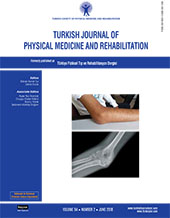Effects of pulmonary rehabilitation in patients with mild-to-moderate chronic obstructive pulmonary disease: Bottom of an iceberg
2 Department of Physical Therapy and Rehabilitation, Ege University Faculty of Medicine, İzmir, Turkey DOI : 10.5606/tftrd.2018.1006 Objectives: This study aims to compare the effects of pulmonary rehabilitation (PR) in patients with mild-to-moderate and severe-to-very severe chronic obstructive pulmonary disease (COPD).
Patients and methods: Between January 2005 and December 2010, a total of 76 patients with mild-to-moderate (Global Initiative for Chronic Obstructive Lung Disease [GOLD] Stages I+II, n=33, mean age 66.0±8.6 years) and severe-to-very severe (GOLD Stages III+IV, n=43, mean age 63.5±8.8 years) COPD completed an eight-week outpatient PR program. Incremental and endurance shuttle walk tests (ISWT, ESWT), St. George`s Respiratory Questionnaire (SGRQ), Chronic Respiratory Questionnaire (CRQ), and Hospital Anxiety and Depression Scale were assessed before and after PR. Changes after the intervention were compared between two groups.
Results: There were significant improvements in the ISWT and median 60 m [(-150)-(400)] in mild-to-moderate group and 70 m [(0)-(270)] in severe-to-very severe group (both, p<0.001). The ESWT time improved in both groups, 122s [(-279)-(665)] (p=0.002) and 61s [(-180)- (878)] (p<0.001), respectively. Significant effects were observed in all domains of the SGRQ except the impact score in mild-to-moderate patients. There were significant improvements in all domains except the symptoms score in severe-to-very severe patients. Using the CRQ, a significant improvement was shown in all domains of CRQ except the dyspnea score of mild-to-moderate patients. Anxiety and depression scores decreased after PR in both groups (p<0.05). According to changes in outcomes, there was no difference in any parameters between two groups.
Conclusion: This study demonstrates that patients with mild-to-moderate COPD benefit from PR comparably to patients with severe-tovery- severe COPD. Although patients with mild-to-moderate COPD are not usually symptomatic, our findings suggest that they should be included in PR.
Keywords : Anxiety; chronic obstructive pulmonary disease; depression; dyspnea; exercise; quality of life; rehabilitation

















